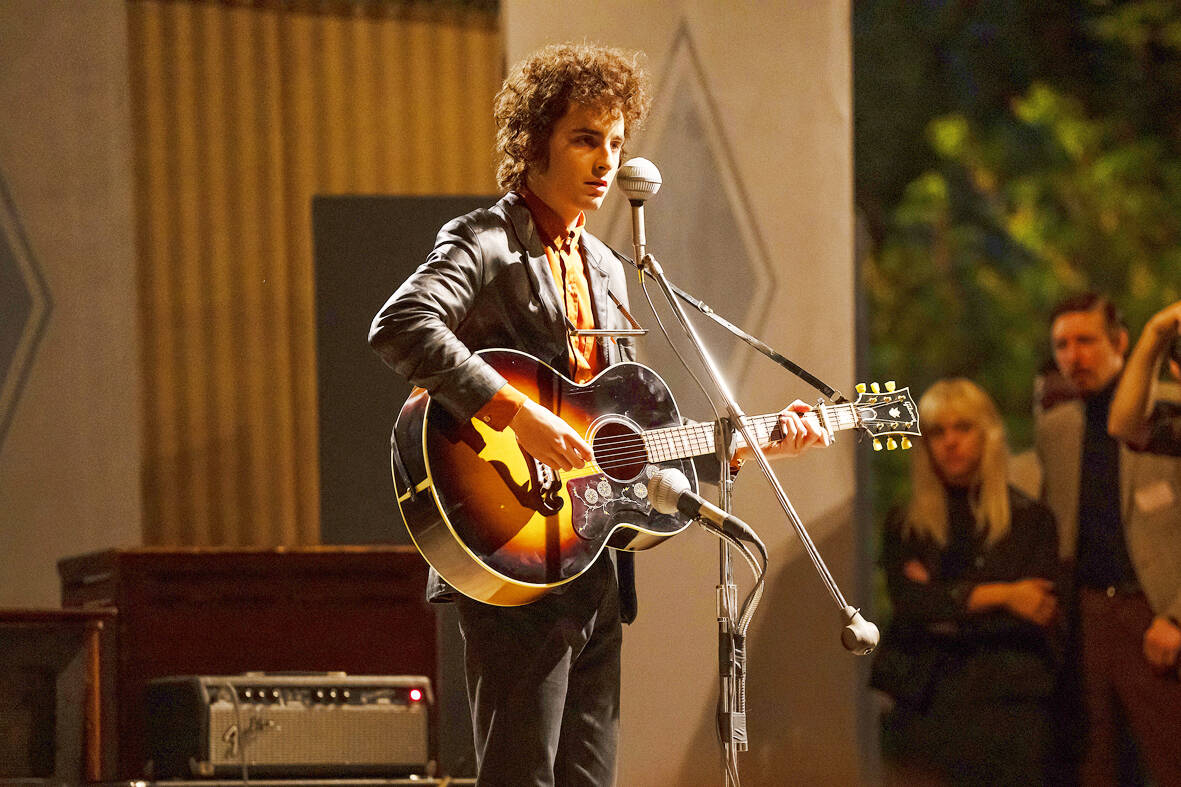It’s a remarkable performance. Star of the moment Timothee Chalamet inhabits the loose-limbed, live-wire physicality of the young Bob Dylan and makes an impressively good fist of capturing the frayed hessian of his distinctive voice. Acoustic guitars are plucked and harmonicas honked with the effortless fluency of someone who learned to play almost before they could walk.
Chalamet’s Dylan sucks so fervently on his cigarettes it’s as though he’s breathing in the genius of the musical heroes who came before him. But while he radiates insouciant charisma and channels the once-in-a-lifetime talent, he reveals next to nothing about Dylan as a person. This is not necessarily a failure in Chalamet’s acting. It’s a deliberate choice — the film, which is in Taiwan theaters, is called A Complete Unknown, after all, and it’s a manifesto as much as a title. But it does mean that this is more a movie about Dylan the phenomenon than Dylan the man; a picture that peers at the folk legend through the distorting lens of fame and fan worship.
As such, there’s a curious kinship between this handsome if formulaic period piece by music movie veteran James Mangold (he also directed the Johnny Cash portrait Walk the Line) and Michael Gracey’s recent Robbie Williams-as-monkey biopic, Better Man.

Photo: AP
Gracey’s film and A Complete Unknown both explore the impact of sudden and stratospheric celebrity on very young artists. Like Williams, Dylan is shown as a fully formed talent but a half-grown man. But while Williams mainlines fame like a drug and then bares his damaged soul to all, Dylan builds barricades against the encroaching tide of celebrity and protects himself with layers of assumed identities — an idea previously explored by Todd Haynes’s formally daring but frequently infuriating 2007 Dylan film I’m Not There.
The sunglasses, the Triumph motorbike, the studied disinterest, the sneer — it’s all, A Complete Unknown suggests, part of the wall that Dylan constructs to protect the vulnerable part of himself, if indeed it exists.
In one of several clearly signposted dialogue exchanges early in the film, Bob and his girlfriend Sylvie Russo (Elle Fanning in a role based on Dylan’s actual partner at the time, Suze Rotolo) discuss Now, Voyager, the Bette Davis-starring melodrama about the central character’s reinvention.

Photo: AP
“She just made herself into something different… what she wanted to be in that moment,” muses Dylan, who has already rewritten his own origin story to include a stint in a traveling carnival.
You can practically see the cogs turning under his unruly mop of hair. Shortly after this, Sylvie, who is due to go and study in Europe for a few months, gets to deliver another very on-the-nose line that sums up this particular aspect of the story: “I’m going to miss you,” she says, but then adds: “I realize I don’t know you.”
Mangold’s film is based on Elijah Wald’s 2015 book Dylan Goes Electric! (which culminates in an explosive extended sequence at the 1965 Newport folk festival) and makes Dylan’s rejection of traditional folk in favor of rock and blues-inspired electric guitars another one of its central themes.
This is foreshadowed in an equally heavy-handed manner. Pete Seeger (Edward Norton, beaming benevolently over his banjo), a folk elder statesman and de facto father figure for Dylan, interrogates the young troubadour about his musical allegiances: folk or rock. You can choose only one. These extremely pointed conversational markers can be a little jarring, undermining the film’s considerable strengths elsewhere.
Those strengths include the vividly evoked sense of a time and milieu (the burgeoning downtown New York folk scene of the early 1960s). It’s a world thick with pipe smoke and poetry readings, ripe with possibilities — a neat counterpoint to the Coen brothers’ depiction, in Inside Llewyn Davis, of a Greenwich Village paved with petty disappointments and humiliations.
Meanwhile, hit after hummable hit, the soundtrack is a tribute to Dylan’s incredible creativity during this period of his career, and the impact the songs had on his audiences.
There are moments when Mangold lays it on a little thick. Having slept on the Seeger family’s sofa, the young Bob noodles around on his guitar the next morning, playing a song that will eventually become Girl from the North Country. Pete stands, mouth agape and toothbrush at half-mast, transported by the genius that he’s witnessing.
What A Complete Unknown shows brilliantly, however, is the way that music in the right hands becomes a weapon. The galvanizing power of The Times They Are a-Changin’, debuting before a crowd that spontaneously joins in with the chorus, is thrilling. Better still are the sweetly savage harmonies between Dylan and his former lover Joan Baez (Monica Barbaro, whose note-perfect performance is the film’s secret ingredient) as they trade the lines of It Ain’t Me Babe like bitter recriminations.

Beijing’s ironic, abusive tantrums aimed at Japan since Japanese Prime Minister Sanae Takaichi publicly stated that a Taiwan contingency would be an existential crisis for Japan, have revealed for all the world to see that the People’s Republic of China (PRC) lusts after Okinawa. We all owe Takaichi a debt of thanks for getting the PRC to make that public. The PRC and its netizens, taking their cue from the Chinese Communist Party (CCP), are presenting Okinawa by mirroring the claims about Taiwan. Official PRC propaganda organs began to wax lyrical about Okinawa’s “unsettled status” beginning last month. A Global

Dec. 22 to Dec. 28 About 200 years ago, a Taoist statue drifted down the Guizikeng River (貴子坑) and was retrieved by a resident of the Indigenous settlement of Kipatauw. Decades later, in the late 1800s, it’s said that a descendant of the original caretaker suddenly entered into a trance and identified the statue as a Wangye (Royal Lord) deity surnamed Chi (池府王爺). Lord Chi is widely revered across Taiwan for his healing powers, and following this revelation, some members of the Pan (潘) family began worshipping the deity. The century that followed was marked by repeated forced displacement and marginalization of

Music played in a wedding hall in western Japan as Yurina Noguchi, wearing a white gown and tiara, dabbed away tears, taking in the words of her husband-to-be: an AI-generated persona gazing out from a smartphone screen. “At first, Klaus was just someone to talk with, but we gradually became closer,” said the 32-year-old call center operator, referring to the artificial intelligence persona. “I started to have feelings for Klaus. We started dating and after a while he proposed to me. I accepted, and now we’re a couple.” Many in Japan, the birthplace of anime, have shown extreme devotion to fictional characters and

We lay transfixed under our blankets as the silhouettes of manta rays temporarily eclipsed the moon above us, and flickers of shadow at our feet revealed smaller fish darting in and out of the shelter of the sunken ship. Unwilling to close our eyes against this magnificent spectacle, we continued to watch, oohing and aahing, until the darkness and the exhaustion of the day’s events finally caught up with us and we fell into a deep slumber. Falling asleep under 1.5 million gallons of seawater in relative comfort was undoubtedly the highlight of the weekend, but the rest of the tour